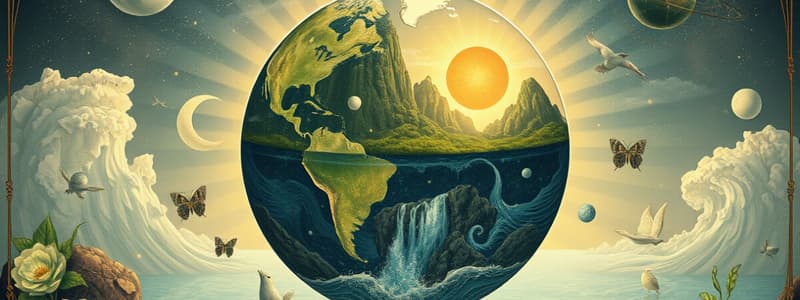Podcast
Questions and Answers
What is the primary component of the hydrosphere?
What is the primary component of the hydrosphere?
The primary component of the hydrosphere is all the water found on our planet, including oceans, lakes, rivers, and streams.
Describe the cryosphere and its significance.
Describe the cryosphere and its significance.
The cryosphere consists of solid water, such as ice and snow, and is significant for regulating Earth's climate and water cycle.
Explain the importance of primary producers in the biosphere.
Explain the importance of primary producers in the biosphere.
Primary producers are crucial as they form the base of the food chain and are capable of photosynthesis, providing energy for all other organisms.
Identify the levels of organization in the biological hierarchy.
Identify the levels of organization in the biological hierarchy.
How do the subsystems of the biosphere interact with the atmosphere?
How do the subsystems of the biosphere interact with the atmosphere?
What role does the hydrosphere play in supporting plant life?
What role does the hydrosphere play in supporting plant life?
Flashcards are hidden until you start studying
Study Notes
Hydrosphere
- Encompasses all water on Earth, including oceans, lakes, rivers, streams, and creeks.
Cryosphere
- Comprises solid water in forms such as ice and snow.
- Key components of the water cycle include:
- Precipitation: Water falling from the atmosphere.
- Collection: Accumulation of water in bodies like lakes and oceans.
- Condensation: Transformation of water vapor into liquid.
- Evaporation: Conversion of liquid water into vapor.
Biosphere
- Represents the life zone on Earth, consisting of all living organisms and undecomposed organic matter.
- Organized in a hierarchical structure known as the food chain, with energy transfer between levels.
- Energy flow example:
- Primary producers (e.g., plants) provide 300 kcal.
- Energy passes to primary consumers (30 kcal).
- Secondary consumers receive 3 kcal.
- Each transfer results in a loss of about 90% energy at each trophic level.
Biological Level of Organization
- Basic unit starts with atoms, progressing through:
- 7 micromolecules and 7 macromolecules.
- Levels of organization include: organ, tissue, cell, organelle.
- Higher levels: organ system, organism, population, community.
- Ultimately forms ecosystems comprising biotic and abiotic components.
Sub-systems Interactions within the Biosphere
- Atmosphere: Provides sunlight and gases; facilitates precipitation essential for life.
- Hydrosphere: Supplies water necessary for plant growth and sustains ecosystems.
- Geosphere: Contains living mediums where organisms thrive and contributes to material manufacturing, like farm machinery.
Studying That Suits You
Use AI to generate personalized quizzes and flashcards to suit your learning preferences.




